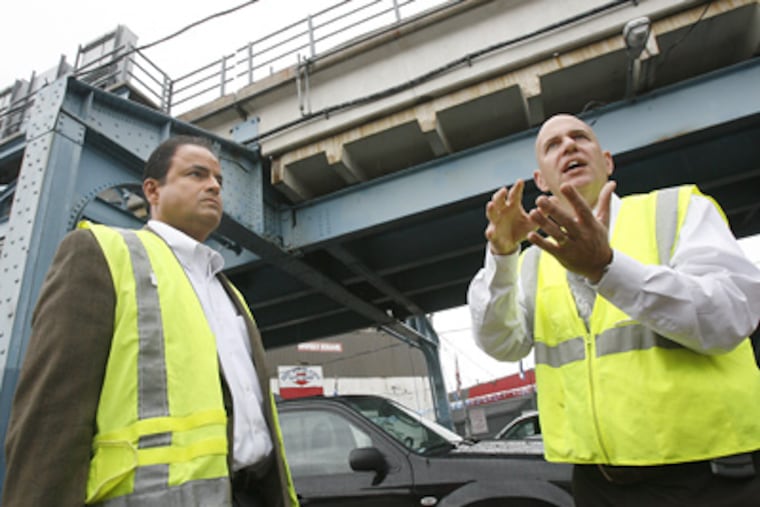Frankford El with potential to crumble needs repairs
The Frankford elevated line, which was completely rebuilt in the 1980s and 1990s to last for 75 years, needs significant repairs because of a basic flaw in its reconstruction design.

The Frankford elevated line, which was completely rebuilt in the 1980s and 1990s to last for 75 years, needs significant repairs because of a basic flaw in its reconstruction design.
To prevent pieces of concrete from falling onto cars or pedestrians, SEPTA crews have installed 8,000 metal mesh belts on the underbelly of the El and plan to install 2,000 more, beginning Monday.
That's a temporary fix, designed to keep the 5.2-mile-long El safe until SEPTA consultants come up with a permanent repair in the next year.
The problem? The El was rebuilt in a way that does not allow its deck to adequately expand and contract with temperature changes, SEPTA chief engineer Jeffrey Knueppel said.
Repairs could cost $20 million or more, Knueppel said.
SEPTA, which has been struggling with the crumbling concrete for years, blames the El flaw on the two engineering companies responsible for the design and the construction management of the structure. SEPTA last month filed suit against the two companies, Parsons Brinckerhoff and Sverdrup (now part of Jacobs Engineering Group Inc.), for the repair costs.
"These were latent defects that were not apparent when SEPTA accepted the El" reconstruction, said SEPTA's general counsel, Nicholas Staffieri. He said SEPTA was seeking an unspecified amount of damages for "errors and omissions" by the engineering companies.
SEPTA filed suit after it failed to reach a settlement with the engineering companies.
A spokeswoman for Jacobs Engineering did not respond to The Inquirer's phone call about the lawsuit and the El reconstruction. A spokeswoman for Parsons Brinckerhoff did not have an immediate response.
The reconstruction of the El cost about $326 million. The work started in 1987 and was not completed until 2000, by which time parts of it were already falling off.
"We're not getting the useful life out of it that we expected," said Ed LaGuardia, assistant chief engineer for SEPTA. The El was initially constructed in 1922.
The reconstruction of the Frankford El was celebrated within engineering circles at the time. In fact, the project won several engineering awards, including the "Grand Conceptor Award" in 1995 from the Consulting Engineers Council of Pennsylvania.
But the design has not aged well.
The issue with the Frankford El lies in concrete beams on the underside of the deck. Unable to move properly over the supporting steel girders, many of the concrete members have chipped and broken, sloughing off pieces of concrete.
The first such "spalling" or crumbling was detected in 1997, but was attributed to faulty construction. The contractors made some repairs, but by 2004, more concrete members were spalling. After an examination by consulting engineers at URS Corp., the design was blamed.
To prevent pieces of the concrete beams from coming off, SEPTA crews bolted wide mesh strips onto the faces of the beams. There are about 44,000 of the beam faces, and about 33,000 are in locations that require them to be evaluated for possible failure, LaGuardia said.
Crews have been dispatched to tap on the beams with hammers to try to detect internal weaknesses. So far, about 2,000 failed beams have been found.
When a flawed beam is found, that beam and several on either side of it are bolstered with the mesh, LaGuardia said.
SEPTA has hired Wiss Janney Elstner Associates Inc. of Northbrook, Ill., to design a permanent repair.
No injuries or damage to vehicles have been reported from falling concrete, LaGuardia said. And train service has not been interrupted by the flaws or the repair work.
SEPTA last week celebrated the $740 million reconstruction of its Market Street elevated line in West Philadelphia, which, together with the Frankford El in Northeast Philadelphia, forms the city's busiest transit route, the Market-Frankford Line.
The newly rebuilt Market Street El was designed and constructed differently than the Frankford El and does not have the same design problem, Knueppel said.